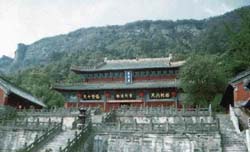
Mount Wudang in central China's Hubei Province has been attracting a growing number of tourists not only for being a sacred place for Taoism and Taoist-inspired arts such as boxing, but also for boasting a legion of ancient Chinese architectures.
In the first five months of the year, the number of visitor arrivals to Mount Wudang, situated inside Shiyan City, Hubei Province, totaled 450,000, almost double that for the same period last year, said an official with the Office of the Mount Wudang Special Economic Zone.
The number of tourist arrivals to the mountain was 860,000 in 2002, including 12,000 overseas tourists. And tourist arrivals to the sacred place for Taoism from January to May that year stood at 280,000.
Adjoining the Qinling Range to the northwest and Shennongjia Primitive Forest Nature Reserve to the south, Mount Wudang stretches over 400 km and consists of 72 peaks, 36 cliffs and 24 valleys.
Mount Wudang, which has a long history associated with Taoism, was included by UNESCO into the World Cultural Heritage List in 1994 for housing a large number of palaces and temples which exemplify the architectural and artistic achievements of China's Yuan, Ming and Qing dynasties and represent the highest standards of Chinese art and architecture over a period of nearly 1,000 years.
The galaxy of palaces and temples, dedicated to Taoism, were built in the scenic valleys and on the slopes of Mount Wudang.
According to historical records, people arrived at the mountain to practice Tao as early as the Jin Dynasty (260-420), but the earliest temples now preserved at Mount Wudang were built in Tang Dynasty (618-907).
Wudang Taoism was characterized by its worship for the Great Perfect Warrior Emperor, its practice of Chinese Inner School Boxing, its advocacy of the integration of the Three Doctrines and its emphasis on Cultivation and Refinement of Inner Alchemy and Spiritual Nature.
Both the imperial families of Song (960-1279) and Yuan (1271-1368) dynasties believed in the spirit of the Great Perfect Warrior Emperor of the north. As a result, Wudang Taoism, became popular during the two dynasties.
All the temples on Mount Wudang were destroyed in wars in late Yuan Dynasty, but at the beginning of the Ming Dynasty (1368-1644),Zhang Sanfeng, a famous Taoist, lived on the mountain in seclusion. He said to others: "This mountain is bound to thrive someday."
Mount Wudang was later honored as "the first famous mountain under heaven" in the Ming Dynasty. Emperor Zhu Di fervently advocated Wudang Taoism as he believed he had been assisted by the Great Perfect Warrior Emperor, the deity of Wudang Taoism, on his way to the throne and issued a decree in 1413 ordering construction of palaces and temples at Mount Wudang.
Over 300,000 soldiers and artisans were led to Mount Wudang, who built, in more than a decade's time, 33 architectural complexes in accordance with stories based on the Perfect Warrior making immortality pills and cultivating vital energy. They also constructed 39 bridges, 12 pavilions and the 70-km-long path stretching from the foot of Mount Wudang to its peak.
Several of the buildings were damaged throughout the ages. But the ancient architectures are still well preserved at 53 places, with the combined floor space totaling 27,230 square meters and 5,000 cultural relics also remain intact, of which, 1,000 are listed for top state protection.
Best known temples are Zixiao, Taihe, Jindian and Yuzhen. Amongthem, the 600-year-old Yuzhen Palace, which covered an area of over 50,000 square meters, represented a typical example in the late imperial Yuan Dynasty and early Ming Dynasty architecture. It had been rented by a private kung fu school.
(Xinhua News Agency June 12, 2004)
|

